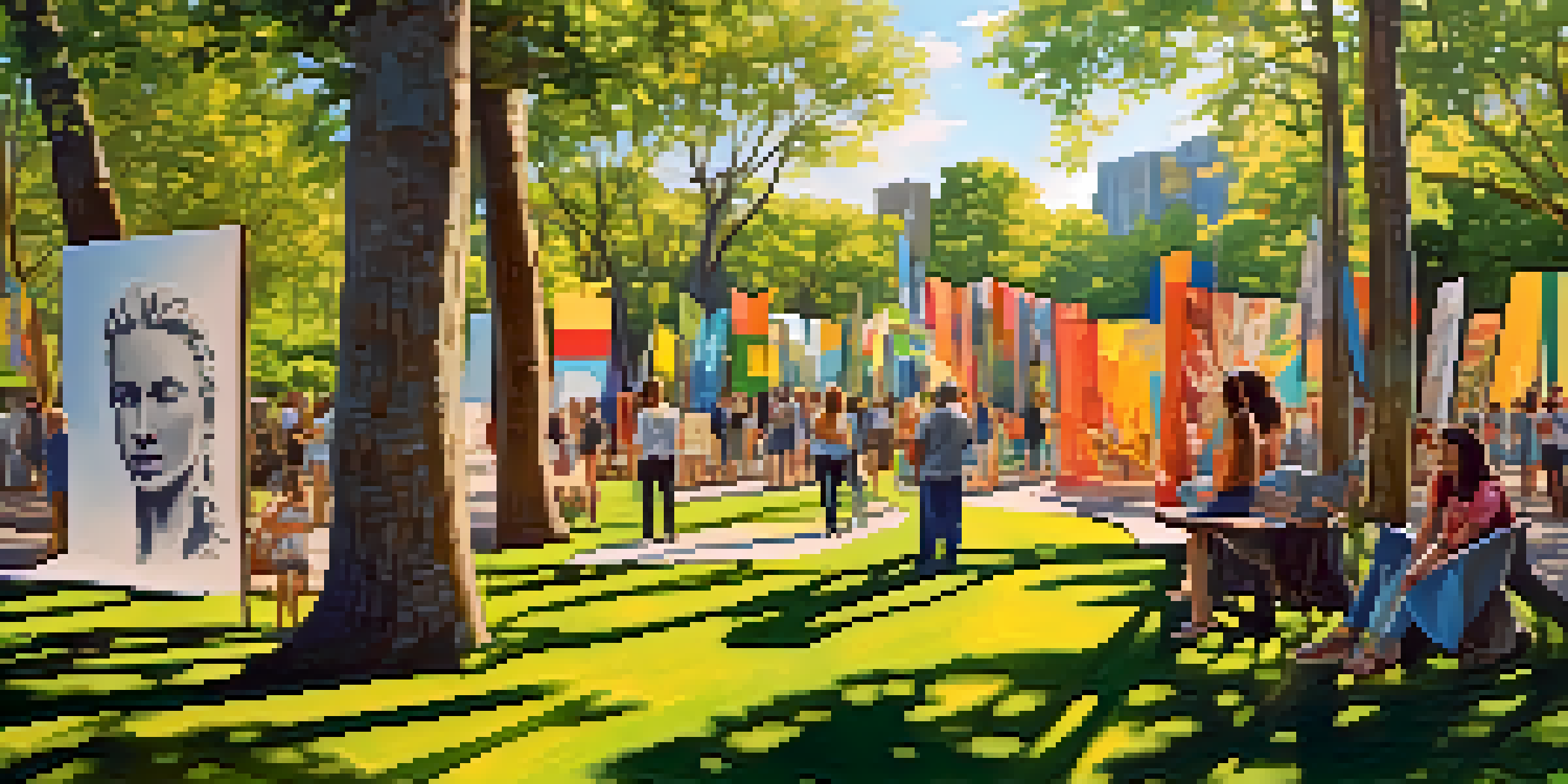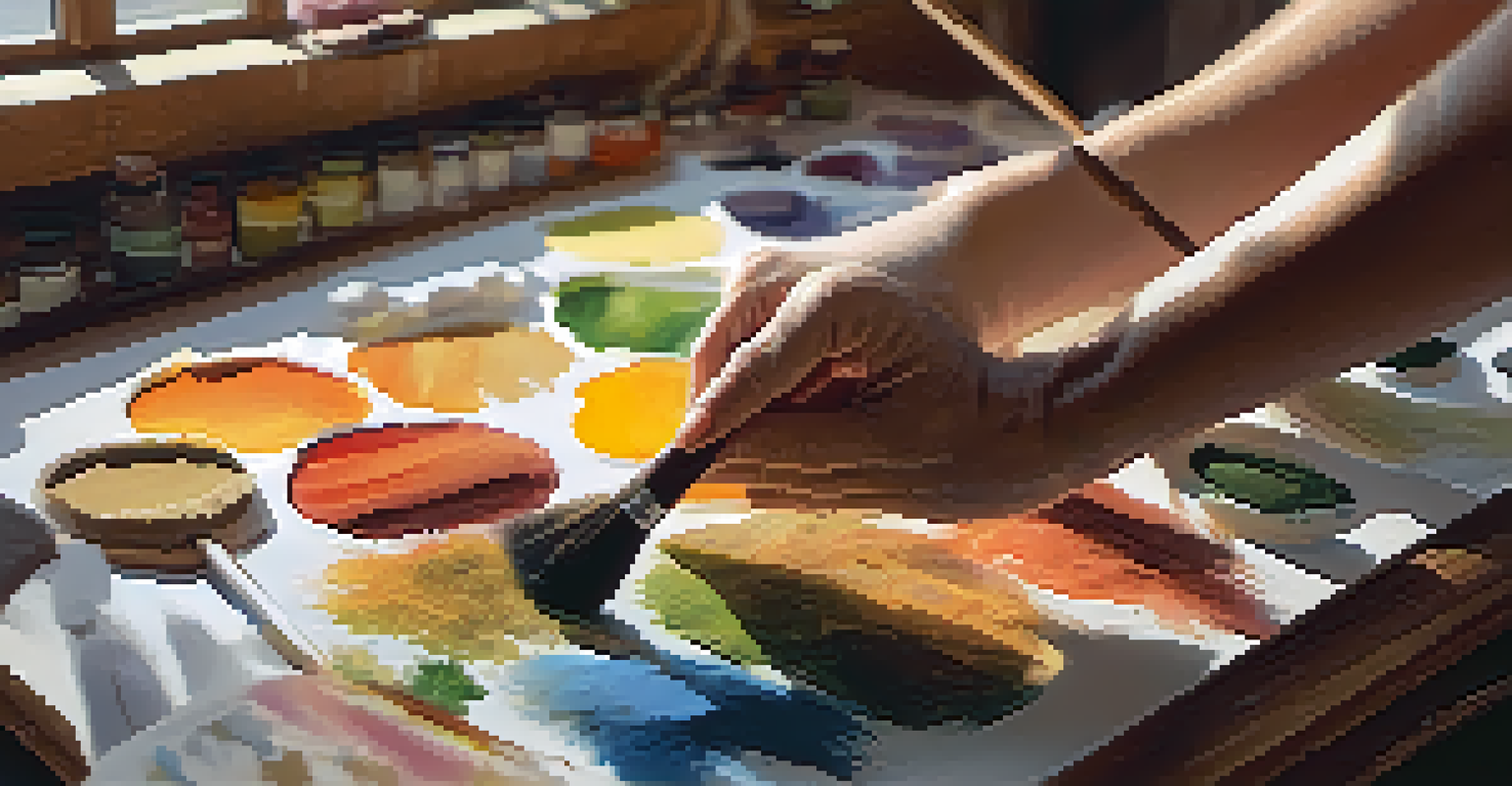Sustainable Art: Creating with Nature in Mind

Understanding Sustainable Art and Its Importance
Sustainable art is an innovative approach that emphasizes ecological responsibility in the creative process. This form of art not only seeks to beautify our surroundings but also aims to make a positive impact on the environment. By using eco-friendly materials and practices, artists contribute to a broader movement that prioritizes the health of our planet.
Art can be a powerful tool for change, inspiring people to think, act, and engage with the world around them.
In a world where environmental concerns are increasingly pressing, sustainable art serves as a powerful medium for raising awareness. Artists often use their work to communicate messages about climate change, pollution, and conservation. This not only educates the public but also inspires action, encouraging viewers to reflect on their relationship with nature.
The importance of sustainable art lies in its ability to blend creativity with activism. By choosing to create art that respects and preserves the environment, artists play a vital role in promoting sustainability. This practice can lead to a cultural shift, where art becomes a catalyst for change and a tool for environmental advocacy.
Materials Matter: Choosing Eco-Friendly Supplies
One of the first steps in creating sustainable art is selecting the right materials. Many artists are opting for natural, recycled, or upcycled items to minimize their environmental impact. For instance, using reclaimed wood or repurposed fabrics not only reduces waste but also adds a unique character to the artwork.

Additionally, artists can explore natural pigments and dyes, derived from plants and minerals, which are far less harmful than synthetic alternatives. This not only ensures a lower carbon footprint but also offers a richer color palette. By being mindful of material choices, artists can significantly reduce pollution and resource depletion.
Sustainable Art Enhances Awareness
Sustainable art serves as a powerful medium for raising awareness about environmental issues, inspiring reflection and action among viewers.
Choosing eco-friendly supplies is not just a trend; it's a responsibility that many artists embrace. By showcasing sustainable materials in their work, they can inspire others to make similar choices. This ripple effect can lead to a more conscious community of creators and consumers alike.
Incorporating Nature in Artistic Inspiration
Nature has always served as a profound source of inspiration for artists. From breathtaking landscapes to intricate floral designs, the beauty of the natural world can spark creativity in countless ways. Artists often find themselves compelled to capture the essence of nature, reminding us of its importance in our lives.
The greatest threat to our planet is the belief that someone else will save it.
By directly incorporating natural elements into their artwork—such as leaves, stones, or even soil—artists can create pieces that tell a story of their environment. This not only enhances the aesthetic value of the art but also strengthens the connection between the audience and nature. It's a beautiful way to celebrate the earth's resources.
Furthermore, engaging with nature during the creative process can have therapeutic benefits for artists. Spending time outdoors can stimulate the mind, reduce stress, and foster a deeper appreciation for the environment. This symbiotic relationship between art and nature ultimately enriches both the artist's work and personal well-being.
The Role of Art in Environmental Activism
Art has long been a powerful tool for social change, and environmental activism is no exception. Artists have the unique ability to provoke thought, spark conversations, and mobilize communities through their work. By addressing pressing environmental issues, they can inspire collective action and change.
Exhibitions, installations, and performances that focus on sustainability can engage audiences in meaningful dialogues about climate change and conservation. For example, ocean-themed art installations have raised awareness about marine pollution, prompting viewers to reflect on their own impact on the oceans. Such initiatives can turn passive observers into active participants.
Eco-Friendly Materials Matter
Choosing natural, recycled, or upcycled materials allows artists to minimize their environmental impact and inspire others to do the same.
Moreover, collaborative projects that involve local communities can amplify the message of sustainability. Through workshops or community art events, artists can educate others about environmental issues while also creating beautiful, impactful work together. This fosters a sense of ownership and responsibility for our planet.
Examples of Sustainable Art Around the Globe
Around the world, artists are embracing sustainable practices in diverse and innovative ways. For instance, the famous 'Trash Isles' campaign, initiated by a group of artists and activists, aims to raise awareness about plastic pollution in the oceans by creating a fictional country made entirely of ocean plastic. This clever concept highlights the severity of the issue while engaging a global audience.
Another noteworthy example is the work of artists like Andy Goldsworthy, who create temporary installations using natural materials found on-site. His sculptures, made of leaves, rocks, and ice, celebrate the beauty of nature while reminding us of its fragility. These pieces often decay and return to the earth, illustrating the cycle of life.
Such projects not only capture attention but also provoke thought about our role in preserving the environment. They serve as a reminder that art can be both beautiful and meaningful, ultimately contributing to a greater understanding of sustainability and environmental protection.
The Future of Sustainable Art: Trends to Watch
As the conversation around sustainability continues to grow, so does the evolution of sustainable art. Artists are increasingly experimenting with new technologies, such as biodegradable materials and digital art forms that reduce waste. This openness to innovation allows for fresh ideas and methods that align with eco-friendly principles.
Additionally, the rise of social media has created a platform for artists to share their sustainable practices with a broader audience. Online communities and virtual galleries allow for collaboration and engagement, fostering a global conversation about the importance of sustainability in art. This interconnectedness can amplify the impact of sustainable art on a larger scale.
Art as a Tool for Activism
Art can mobilize communities and provoke dialogue around pressing environmental issues, turning passive observers into active participants in sustainability efforts.
Looking ahead, we can expect to see a deeper integration of sustainability into art education and institutions. As future generations of artists become more conscious of their environmental footprint, sustainable art will likely become a standard practice rather than a niche. This shift could lead to a more environmentally aware art community, inspiring change across various sectors.
How You Can Support Sustainable Art
Supporting sustainable art doesn't require you to be an artist yourself; there are many ways to get involved! One of the simplest actions you can take is to seek out and purchase art from artists who prioritize eco-friendly practices. By choosing to invest in their work, you are directly supporting their mission of environmental stewardship.
Another way to contribute is by attending local art shows, workshops, or exhibitions that focus on sustainability. These events often provide an opportunity to learn more about eco-friendly practices while engaging with artists and other community members. Plus, you might discover new artists and gain insights into their creative processes.

Lastly, you can advocate for sustainable art by sharing your findings and experiences with friends and family. Start conversations about the importance of sustainability in art and encourage others to make eco-conscious choices. By spreading awareness, you can help create a community that values and supports sustainable artistic practices.